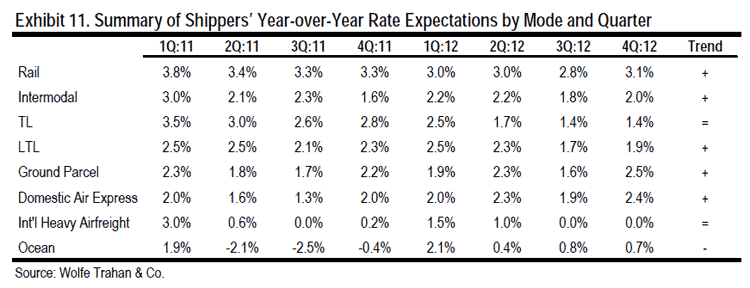From SCDigest's On-Target E-Magazine
- March 12, 2013 -
Supply Chain News: Summary of Latest State of the Freight Report from Wolfe Trahan
Shippers Expecting 3.1% Increase in Rail Rates in 2013, Just 1.4% for Truckload; Conversion to Rail and Intermodal Continues
SCDigest Editorial Staff
SCDigest is always interested to see the quarterly "State of the Freight" report from the transportation industry analysts at Wall Street research firm Wolfe Trahan. Though the report is really designed to provide insight to current and potential investors in the transportation sector, invariably there is also much to be gained from the research for shippers as well.
The Q1 2013 report as usual is based on a detailed survey by shippers from several hundred companies who responded in the latter part of Q4 2012.
SCDigest Says: |
 |
| All told, Wolfe Trahan believes that freight volumes and rates will "re-accelerate throughout 2013 after slowing throughout 2012." |
|
What Do You Say?
|
|
|
|
The report is modestly upbeat in terms of the freight market, with shippers expecting "same store" [meaning no outside changes, such as from an acquisition, for example] shipping volumes to rise a decent 3.3% in 2013, the highest level in more than a year, and up from 2.4% last quarter.
Most of that growth, however, is expected to come from increases in rail and intermodal volumes, expected to be up 4.4% and 3.4%, respectively, consistent with data from the Cass Freight Index last week that saw sharp increases in rail and intermodal volumes in February.
Shippers also expect relatively solid growth in ocean (+3.4%) and US ground parcel (+2.4%) volumes, followed by truckload (+2.1%) and less-than-truckload volumes (+1.9%).
However, respondents expect international airfreight volumes to decline almost 2% over the next twelve months, consistent with recent industry trends and the only mode in which shippers expect volume contraction.
All told, shippers in the survey expect total transport budgets to rise 4% including fuel surcharge costs over the next 12 months, up from 3% in the past quarter, which was actually a three-year quarterly low in terms of spend expectations.
What Way to Shippers See Rates Headed?
One of the most interesting charts always included in the quarterly report is one related to where shippers expects rates to be headed across modes, net of fuel changes.
As shown in the chart below, shippers expect rail rates to rise the sharpest this year, at 3.1%, followed by ground parcel at 2.5%. Respondents expect truckload and LTL rates to rise just 1.4% and 1.9%, respectively.

As we've noted in the past, rate expectations in this report tend have tended to underestimate rate increases versus those reported by carriers across modes in their earnings calls over the past two years. SCDigest has in the past and once again here suggests that could be the result of one of two phenomena: (1) over confidence in a shipper relative to its ability to negotiate lower rate increases; or (2) the fact that this survey is primarily composed of very large shippers, which may in fact achieve somewhat smaller increases than the overall market.
Slowing in China Outsourcing Bodes Poorly for International Air Volumes
The anecdotal evidence of increased interest in bringing manufacturing back to the US or at least "near-shoring" to Mexico or Latin America has been supported in this survey for two years, and that was once again the case this quarter.
As the report says, "37% of shippers currently have no plans to change their production sourcing, down slightly from 38% last quarter. Among those who plan to shift their production sourcing, 22% of shippers expect in-sourcing back to the United States, in line with last quarter and up from 17% the year ago period. This again marks one of the highest levels of expected in-sourcing to the US since we began asking this question over two years ago and this likely reflects the impact of cheap natural gas and crude oil in the US as a result of the shale revolution which is allowing for cheaper domestic industrial production."
(Transportation Management Article Continued Below)
|